Mollies (Poecilia sphenops) are wonderful fish, and come in a huge variety of colors and fin shapes.
Hardy and active, if given the right conditions, they’ll live for 3-4 years and produce thousands of babies in their lifetime.
And in this guide, I’ll teach you everything you need to know about caring for them.
Table of Contents
Molly Fish Quick Care Information
Key Characteristics
- Size: 4-6 inches
- Life span: 3-4 years
- Living zone: mid level
- Diet: Carnivorous
- Temperament: Active shoaling fish
Water Parameters
- Temperature: 75°-80°F (24°-26.7°C)
- Ammonia/Nitrite: 0 ppm
- Nitrate: <30 ppm
- pH: 7.5-8.5
- GH: 12-25 dGH (200-416 ppm)
- KH: 10-25 dkh (178-450 ppm)
Care Schedule
- Daily: Feeding and temperature check
- Weekly: Test for ammonia, nitrite, and nitrate. Perform 25% water change
- Monthly: Equipment check, plant trimming
Scientific Classification
- Kingdom: Animalia
- Phylum: Chordata
- Class: Actinopterygii
- Order: Cyprinodontiformes
- Family: Poeciliidae
- Genus: Poecilia
- Species: P. sphenops
- Binomial name: Poecilia sphenops
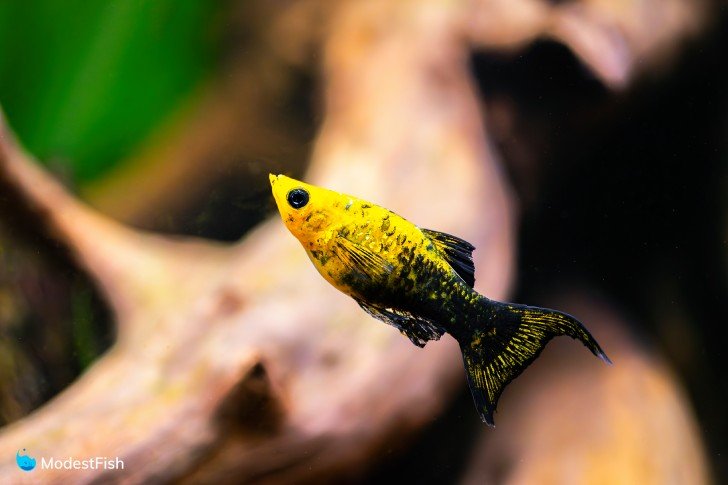
Tank Set Up Overview
Tank Supplies
29 gallon tank (although, bigger is better)
Heater
Strong Filter
Aragonite sand substrate
Live plants & decorations
Thermometer
Water test kit
Gravel Vacuum
Water Conditioner
5 gallon bucket
Diet
Algae
ZooMed Spirulina 20
Omega One Freshwater Flakes
Omega One Veggie Round
Repashy Soilent Green
Molly Fish Origins & In Aquarium Hobby
There are several different species of fish sold under the name “molly.” They all come from the genus Poecilia and their native range runs from Central America, up along the Gulf and Atlantic coasts, ending in the Carolinas.
Mollies are tough little fish that can adapt to a wide range of conditions in the wild. They can be found in fresh, brackish or even saltwater environments. Molly fish typically inhabit areas with fairly dense vegetation that they use as cover from predators. They shoal together and search for algae and small crustaceans.
The most common types of mollies found in the aquarium hobby are shortfin mollies (Poecilia sphenops) and sailfin mollies (Poecilia latipinna).
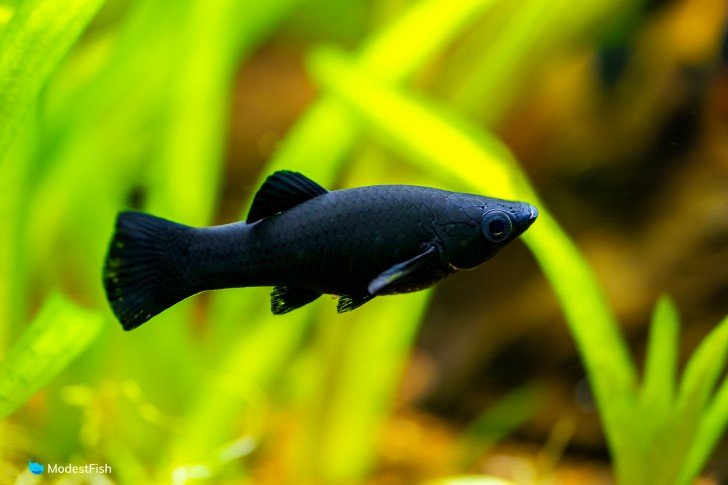
Short-fin mollies have an overall body shape that looks similar to platy fish, but with a deeper chest and belly. They have smaller tails and fins that really aren’t very showy. These varieties are usually smaller, only growing to 4 inches (10 centimeters) or so.
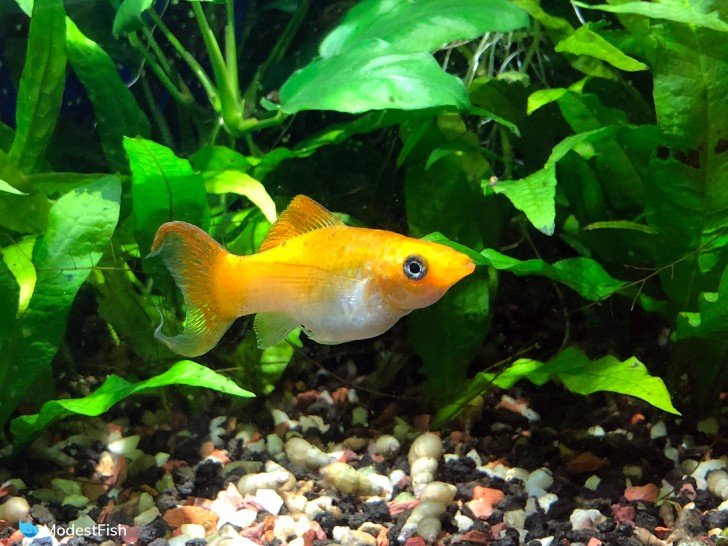
Sailfin mollies have much larger dorsal and caudal (tail) fins. They are also often larger than shortfins, some getting up to 6 inches (15 centimeters) long.
If you’re interested, you can read more about the types of molly fish here. Although, they all
How To Set Up Your Molly Fish Aquarium
Before you’re able to add any fish to your aquarium, you first must cycle the tank in order to provide a safe environment.
During this process, you establish beneficial bacteria in your filter’s media that’ll then turn ammonia (poisonous), into nitrites (poisonous), into Nitrate (not so poisonous).
You can learn exactly how to do this with our step-by-step guide on cycling your tank.

Water Parameters
- Temperature: 75°-80°F (24°-26.7°C)
- Ammonia/Nitrite: 0
- Nitrate: <30 ppm
- pH: 7.5-8.5
- GH: 12-25 dGH (200-416 ppm)
- KH: 10-25 dkh (178-450 ppm)
Pro Tip: Adding crushed coral to your substrate, or in a mesh bag in your filter, can help increase the hardness and pH of your water. The crushed coral will slowly leach calcium and carbonate into the water column.
Do Molly Fish Need Salt in Their Tank?
There’s a huge debate among aquarists about whether or not you should add salt to the water in a molly tank. I actually have to say that both sides of the argument are right.
Mollies don’t actually need salt in their water. They can just adapt to saltwater/brackish conditions if they have to. But, adult mollies that have been reared in nothing but saltwater may need salt added to their tank because their bodies are used to living with high salinity.
Pro Tip: When buying mollies, ask whether or not they were imported so you can decide about adding salt to your tank. You can assume that mollies from big chain stores were bred overseas and will need some salt in the water, at least at first.
Equipment For Your Molly Tank
- 29 gallon tank (although, bigger is better)
- Heater
- Filter
- Aragonite sand substrate
- Live plants & decorations
- Thermometer
Heater
Mollies are a tropical fish that needs temperatures in the range of 75°-80°F (24°-26.7°C).
A heater is an absolute necessity that’ll keep the water warm and hold it at a steady temperature. After testing I found Fluval E series to be the safest and most accurate heater.
Filtration
Mollies might be super cute, but they’re also really messy. Basically, they’re little machines that do nothing but eat, poop and make babies.
You need to make sure you have a filter that can hold enough beneficial bacteria to keep up with processing the tons of waste put off by mollies. Get a filter that can hold a lot of biomedia and always add as much filtration as possible, maybe even adding on an extra filter, like an internal or sponge filter.
For hang-on-back filters I recommend the Seachem Tidal series. They have an amazing amount of room for filter media. The reservoir in the back of the filter is very wide and deep, providing a large space that you can fill with whatever mechanical, biological or chemical filter media your heart desires.
For larger tanks, 55 gallons and up, I recommend you look into a canister filter like the Fluval 407, Ehiem classic, or OASE biomaster.
Whatever filter you go for, ensure the GPH is rated for your tank.
Substrate
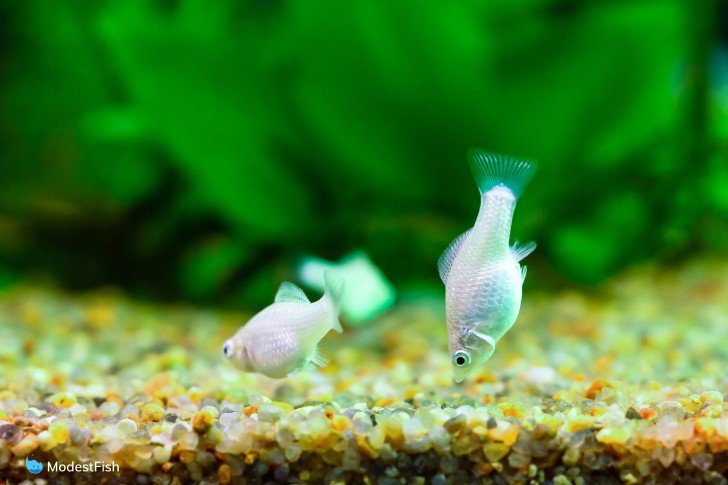
Mollies will benefit from an aragonite sand substrate. Aragonite is made of calcium carbonate (CaCO3) that will slowly leach minerals that the fish will appreciate.
If you’re absolutely set on a gravel substrate, consider adding several cups of crushed coral to the gravel. It will function the same as aragonite.
Plants and Decor
Mollies are an active, top dwelling fish. So they need lots of open swimming areas.
But, they also enjoy densely planted areas and maybe some rocks or decor that provides a few hiding areas. A mixture of aquarium rocks, driftwood, and plants always looks appealing with molly fish.
Some plants you can try are:
- Java fern
- Java moss
- Anubias
- Rotalas
- Cryptocorynes
- Christmas moss
Tank Mates
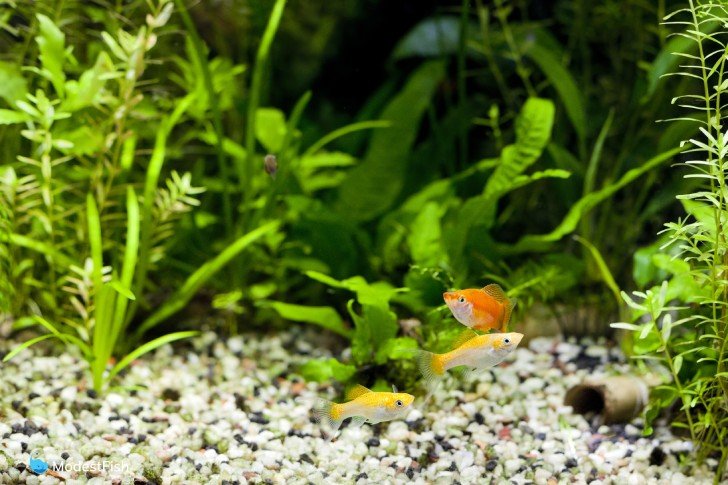
It’s important to note that mollies are extremely social shoaling fish. So, they’re happier if kept in groups.
It’s best to only have one male for every two-three females. Males harass females constantly, trying to mate with them. Having several females means no one fish is being stressed by the male’s attention.
For tank mates from other species, mollies are fairly peaceful fish, but they do get a lot bigger than many species. They’re also greedy feeders that can outcompete smaller fish for food.
Because of this, I’d recommend going with other peaceful but fast-moving community fish, or fish that inhabit a different level of the aquarium.
Some good choices are:
- Corydoras catfish
- Tetras
- Danios
- Swordtails
- Clown and Bristlenose Plecos
- Platies
Feeding Mollies
Mollies really are not picky eaters and will gladly devour any food you put in front of them.
High quality flake food, like ZooMed Spirulina 20 or Omega One Freshwater Flakes makes a good staple diet.
| Preview | Product | |
|---|---|---|

|
Zoo Med Spirulina 20 Flake Fish Food, 4-Ounce | Buy on Amazon |

|
Omega One Freshwater Flakes, 1 oz | Buy on Amazon |
Last update on 2024-04-13 / Commissions Earned / Images from Amazon Product Advertising API
Mollies also really enjoy picking at algae. So, it’s good to provide them with a varied diet that includes algae in the ingredients, like Omega One Veggie Rounds or Repashy Soilent Green.
| Preview | Product | |
|---|---|---|

|
Omega One Veggie Rounds, 14mm Rounds, Sinking, 8 Oz Container | Buy on Amazon |

|
Repashy Soilent Green 6 Oz JAR | Buy on Amazon |
Last update on 2024-04-13 / Commissions Earned / Images from Amazon Product Advertising API
Giving them a healthy, varied diet is important for overall fish health and improves their color.
Maintenance Schedule for Molly Fish
Equipment required for weekly water changes:
- Water test kit (I recommend API Master Test Kit)
- Gravel Vacuum
- Water Conditioner
- 5 gallon bucket
- Scissors for trimming plants
Daily tasks include, feeding once and checking tank temperature. Weekly, test for pH, ammonia, nitrites, and nitrates and perform a 25% water change. Monthly, you’ll want to do an equipment check to ensure everything’s working.
For trimming plants, this is up to you. Trim whenever you see fit.
Breeding Molly Fish
Mollies are livebearers, meaning they give birth to live fry instead of laying eggs.
Breeding mollies is really easy:
- Fill a tank with water.
- Put mollies in it.
- Wait about 60 days
It’s pretty much just that easy.
But seriously, healthy mollies will produce batches of fry every month or so.
Adults will eat the fry so they need lots of hiding areas, like in dense areas of live plants, so they can avoid hungry adults until they grow too big to eat. Java moss and christmas moss are excellent choices for this.
Are Molly Fish Right for You?
Mollies are really interesting fish that come in a huge variety of colors and different fin shapes.
They’re a hardy fish that’s always active. Given the right conditions, they can live for 3-4 years and produce thousands of babies in their lifetime.
So it’s important to decide whether you’re just going to let adults eat the fry, separate the fry and raise them and what you’d do for homes for the fry that make it.
It’s best to have a plan in place so you don’t end up with a bunch of baby mollies that you don’t know what to do with.
It’s also important to consider that mollies get quite a bit bigger than many community fish. You’ll need a larger tank to keep this species since they put off so much waste.
Overall, I do think they make a great pet, if you have the right conditions to house them. They have inquisitive personalities that you’ll find quite charming.

Lovely article. I am a molly fish keeper myself and have kept and bred thousands of mollies. I guess mollies are always underrated and given less importance as guppies and platys are given.
But mollies are a lovely, hardy fish to keep.
I’ve also started sharing my experience on how to keep and breed mollies. Would love to share it with others.